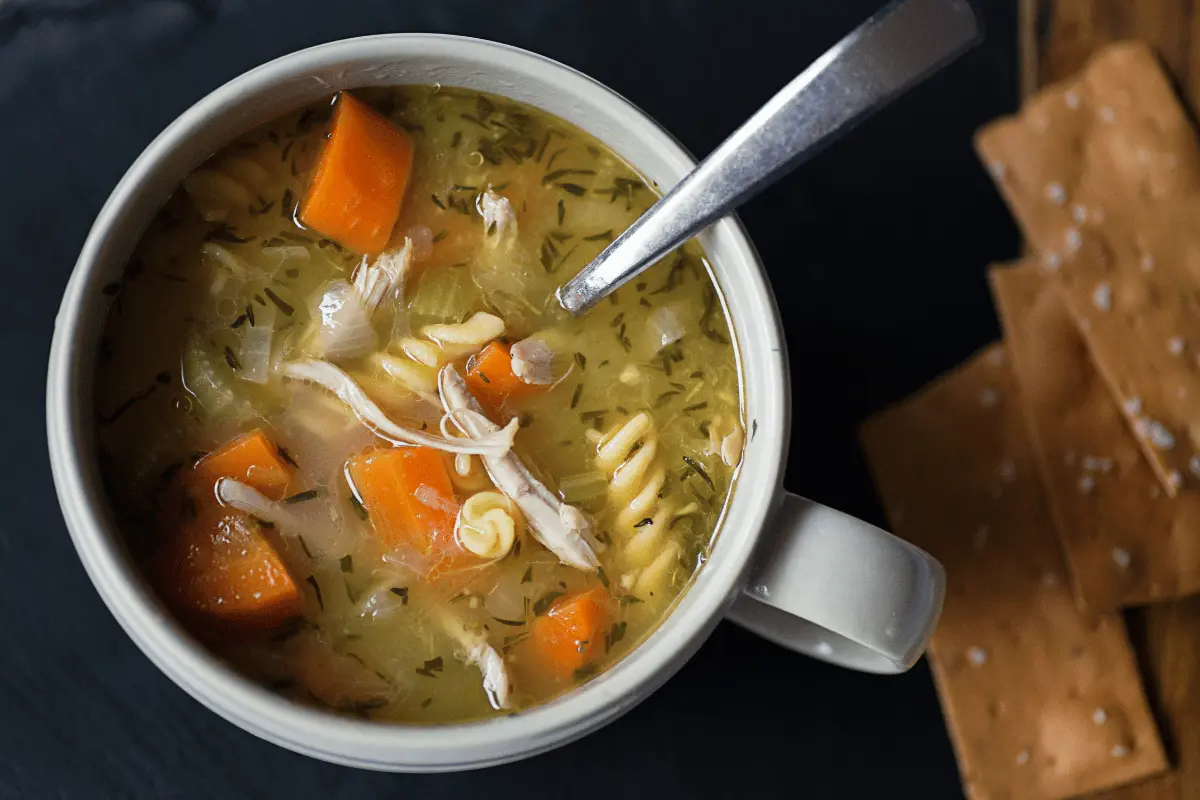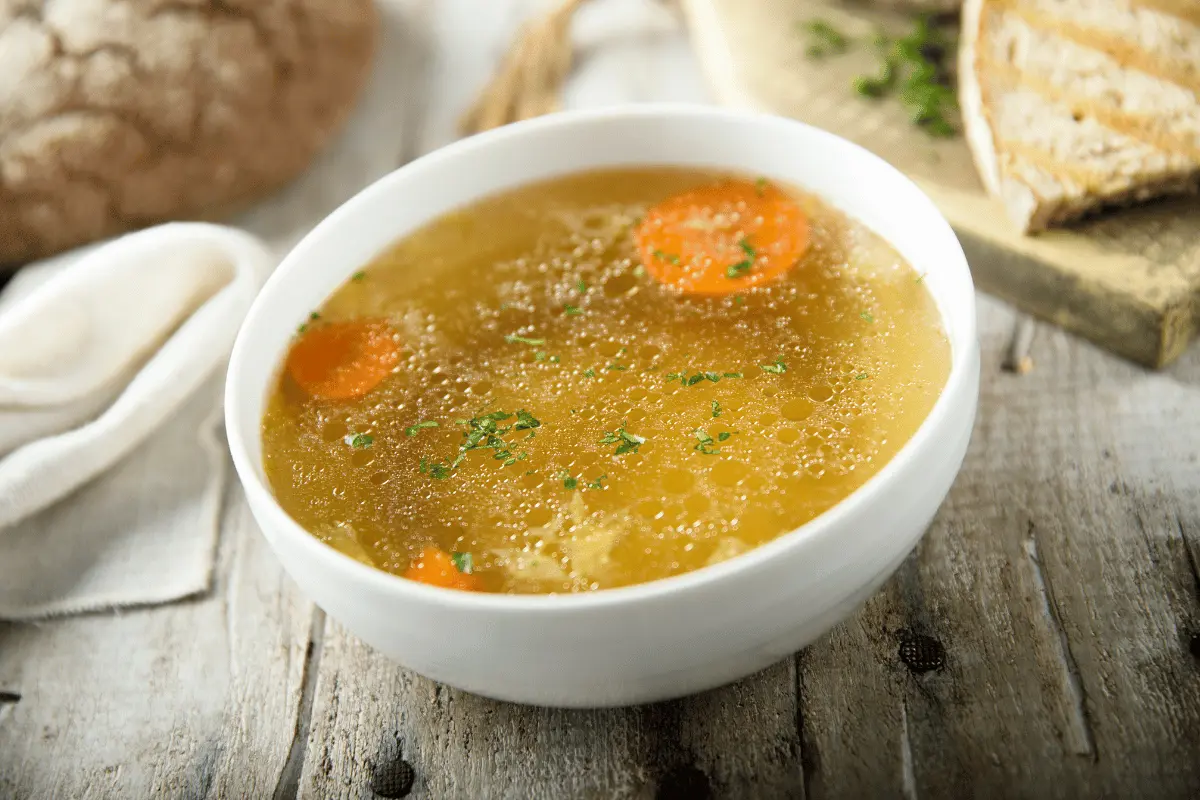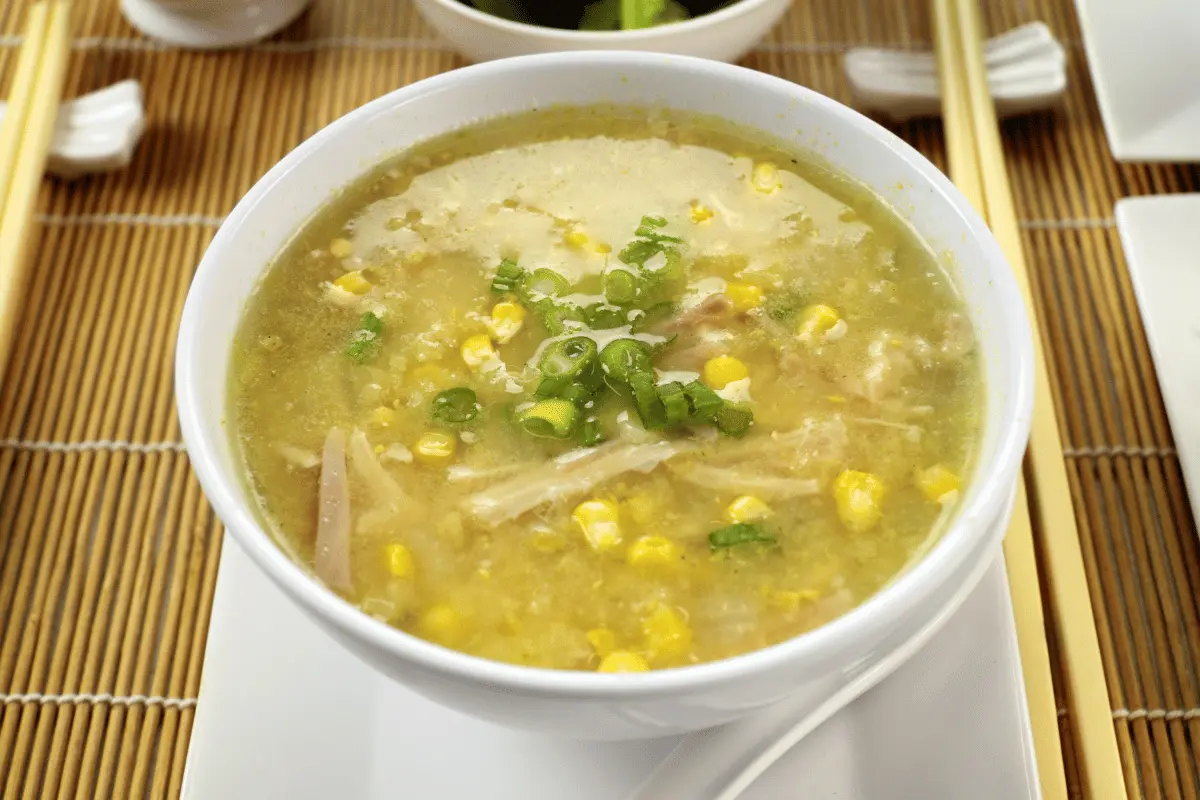Welcome to the ultimate guide on Chicken Souse, a dish that’s not just a meal but a journey into the heart of Caribbean cuisine. This article will take you through the vibrant world of Caribbean Chicken Soup, exploring its rich history, diverse ingredients, and the many ways it can be prepared and enjoyed. Whether you’re a seasoned chef or a curious foodie, this guide promises to enrich your culinary repertoire with flavors, techniques, and stories from the Caribbean islands. So, let’s embark on this flavorful adventure and discover the magic of Chicken Souse!
Introduction to Chicken Souse
Chicken Souse, a staple in Caribbean cuisine, is more than just a dish; it’s a cultural symphony of flavors and traditions. Originating from the islands, this hearty soup has become a beloved comfort food, known for its unique blend of spices, tender chicken, and a broth that’s both zesty and soothing.
The Origins and Cultural Significance of Chicken Souse
The story of Bahamian Chicken Dish begins in the warm kitchens of the Caribbean. This dish, with its humble beginnings, has roots in the Bahamian culinary tradition. It’s a testament to the resourcefulness and creativity of the islanders, who transformed simple ingredients into a dish that’s now celebrated across the globe. Chicken Souse isn’t just food; it’s a part of the Caribbean’s soul, often served at family gatherings, festive occasions, and as a weekend treat.
Overview of Its Popularity in Caribbean Cuisine
In the Caribbean, Chicken Soup is more than a recipe; it’s a ritual. Every island has its own version, each boasting local flavors and personal touches. From the bustling streets of Nassau to the serene beaches of Barbados, Chicken Souse is a common thread that weaves through the culinary tapestry of the region. Its popularity stems from its versatility, ease of preparation, and the ability to bring people together, making it a cherished dish among locals and tourists alike.
Ingredients and Substitutions
When it comes to making authentic Caribbean Chicken Soup, the magic lies in its ingredients. Each component brings its own unique flavor and texture, creating a dish that’s both complex and harmonious.
Essential Ingredients for Authentic Caribbean Chicken Soup
At the heart of Spicy Chicken Broth are chicken wings, known for their rich flavor and tender meat. They simmer in a broth of fresh lime juice, which adds a zesty kick. Spices like paprika and garlic powder contribute depth, while salt and black pepper enhance the overall taste. The dish also features a mix of vegetables – onions, green peppers, carrots, and potatoes – each adding its own note to the melody of flavors.
Substitutions for Common Ingredients
But what if you can’t find all the traditional ingredients, or you’re catering to different dietary needs? No worries! You can easily swap chicken wings with thighs or drumsticks. Just remember to keep the skin on for that rich flavor. If lime juice isn’t available, lemon juice or even vinegar can be great alternatives. For those who don’t prefer green peppers, bell peppers make a fine substitute. And if you’re out of carrots, try parsnips or turnips. They’ll add a similar sweetness and texture to your Chicken Souse.
Step-by-Step Cooking Guide

Cooking Chicken Souse is an adventure in itself. It’s a process that’s both simple and rewarding. Let’s dive into the steps to create this Caribbean delight.
Cooking Chicken Souse: A Step-by-Step Guide
- Marinate the Chicken: Begin by mixing lime juice, paprika, garlic powder, salt, and black pepper in a bowl. Coat the chicken wings in this mixture and refrigerate for at least an hour. This step ensures the chicken absorbs all the flavors.
- Sauté the Vegetables: Heat some oil in a large pot. Add chopped onions and green peppers. Cook them until they’re soft, which usually takes about 6-8 minutes.
- Combine Ingredients: Next, add the potatoes and carrots. Then, put in the marinated chicken wings and bay leaves. Season with red pepper flakes and ground allspice for that extra zing.
- Simmer the Souse: Pour in the remaining lime juice and water. Bring everything to a simmer. Then, reduce the heat and cover the pot. Let it cook until the chicken is done and the veggies are tender. This should take about 35-40 minutes.
- Final Touches: Before serving, remove the bay leaves. This step is crucial for the perfect Chicken Souse experience.
Tips for Achieving the Perfect Flavor and Texture
- Marinating Time: Letting the chicken marinate for a few hours can significantly enhance the flavor.
- Slow Cooking: If you have a slow cooker, use it. Slow cooking allows the flavors to meld beautifully and makes the chicken incredibly tender.
In the next part, we’ll explore the various ways you can tweak this recipe. We’ll look at regional variations and how you can customize Chicken Souse to suit your palate.
Variations of Chicken Souse
Chicken Souse is a dish that invites creativity. Across the Caribbean, cooks add their personal touch, making each version of this dish unique. Let’s explore some delicious variations you can try at home.
For those who enjoy exploring different chicken recipes, our ‘Chicken of the Woods‘ recipe offers another delicious culinary adventure.
Delicious Variations of Chicken Souse
- Coconut Curry Chicken Souse: For a creamy twist, add about half a cup of full-fat coconut milk and a sprinkle of curry powder. This version is rich and flavorful, offering a delightful change from the traditional recipe.
- Spicy Chicken Souse: If you love heat, add half a teaspoon of diced scotch bonnet peppers. This will bring a fiery kick to your dish, perfect for those who enjoy a bit of spice in their meals.
- Herbed Chicken Souse: For a fresh and earthy flavor, add chopped thyme, parsley, or cilantro before serving. Herbs can transform the dish, adding a new dimension to its taste.
Each variation offers a unique experience, allowing you to travel the Caribbean through your taste buds. Experiment with these ideas or create your own version, tailoring the dish to your liking.
Nutritional Information and Benefits

Chicken Souse isn’t just a feast for your taste buds; it’s also packed with nutrients that are good for your body. Let’s break down the nutritional benefits of this wholesome dish.
Nutritional Profile of Chicken Souse
Chicken wings, the star of the dish, are a great source of protein, essential for muscle growth and repair. The vegetables like carrots, potatoes, and onions add fiber, vitamins, and minerals. These nutrients support digestion, boost immunity, and maintain overall health. Lime juice, a key ingredient, is rich in vitamin C, known for its antioxidant properties.
Health Benefits of Key Ingredients
- Chicken: Provides high-quality protein and essential amino acids.
- Carrots: Rich in beta-carotene, which is good for eye health.
- Potatoes: A good source of potassium, which helps regulate blood pressure.
- Onions: Contain antioxidants and compounds that fight inflammation.
Dietary Considerations
While Chicken Souse is nutritious, it’s important to consider portion sizes, especially if you’re watching your calorie intake. The dish can be high in sodium, so it’s wise to moderate your salt use if you have dietary restrictions.
Serving and Pairing Suggestions
Now that you’ve mastered the art of making Chicken Souse, let’s explore the best ways to serve and enjoy this delightful dish. After all, a great meal is not just about taste but also about presentation and pairing.
Serving and Enjoying Chicken Souse
Firstly, consider the setting. Chicken Souse is perfect for both casual family dinners and more formal gatherings. Serve it hot, ideally in a deep bowl to retain its warmth and aroma. Garnishing with fresh herbs like cilantro or parsley not only adds flavor but also enhances its visual appeal.
Ideal Accompaniments and Side Dishes
Moreover, Chicken Souse pairs wonderfully with a variety of side dishes. For a traditional Caribbean experience, serve it with Johnny cakes or steamed white rice. These sides complement the soup without overpowering its flavors. For a healthier option, a light salad with a citrusy dressing can balance the richness of the souse.
Creative Serving Ideas
Additionally, consider serving Chicken Souse in a bread bowl for an inventive twist. This not only makes for an interesting presentation but also adds a delightful textural contrast. Remember, the key to a memorable meal is not just the food but also how you present it.
Storage and Reheating Tips
Proper storage and reheating are crucial for enjoying Chicken Souse even after the day it’s cooked. These tips will help you keep the dish as delicious as it was when you first made it.
Storing and Reheating Chicken Souse
- Cooling Before Storage: Always let the Chicken Souse cool to room temperature before storing. This prevents bacterial growth and maintains the quality of the dish.
- Refrigeration: Store the souse in an airtight container in the refrigerator. It usually stays good for 3-4 days. Remember, freshness is key for the best flavor.
- Freezing for Longer Storage: If you want to keep it longer, Chicken Souse freezes well. Use a freezer-safe container or bag, and it can last up to three months. This is a great way to have a quick meal ready for busy days.
- Reheating: When reheating, do it slowly over medium heat. This ensures that the chicken and vegetables warm up evenly without becoming overcooked. If it’s frozen, thaw it in the refrigerator overnight before reheating.
Tips for Best Reheating Practices
- Avoid microwaving as it can unevenly heat the soup and alter its texture.
- Adding a little water or broth can help if the souse has thickened in the fridge.
By following these storage and reheating tips, you can enjoy Chicken Souse at its best, even days after preparing it. In the next part, we’ll answer some frequently asked questions about Chicken Souse, so stay tuned for more insights!
Frequently Asked Questions About Chicken Souse

In this concluding section, let’s tackle some of the most commonly asked questions about Chicken Souse. These insights will not only deepen your understanding of the dish but also inspire you to experiment with your own versions.
FAQs About Chicken Souse
- Making Chicken Souse Vegetarian: Wondering if you can skip the chicken? Certainly! Swap the chicken for butternut squash or additional root vegetables. This way, you still capture the essence of the dish’s rich flavors.
- Gluten-Free Concerns: Naturally, Chicken Souse is gluten-free as it typically doesn’t include wheat products. However, it’s always wise to double-check the ingredients of your broth and seasonings.
- Spicing It Up: Craving more heat? Simply add extra red pepper flakes or fresh chili peppers. Remember, you can adjust the spice level to suit your taste buds.
- Kid-Friendly Versions: When serving Chicken Souse to kids, it’s a good idea to tone down the spices. Pairing the dish with rice or bread makes it more appealing to little ones.
- Health and Nutrition: Is Chicken Souse a healthy choice? Indeed, it’s packed with protein and veggies. Just be cautious about sodium levels and portion sizes to keep it diet-friendly.
- Freezing and Storage: How long can you freeze Chicken Souse? When stored correctly, it can last up to three months in the freezer. Use airtight containers to maintain its freshness and quality.
By addressing these common questions, we aim to enhance your Chicken Souse experience. This dish is more than just a meal; it’s a vibrant celebration of Caribbean flavors and culinary traditions. We hope this guide has inspired you to bring the warmth and zest of the Caribbean into your own kitchen.
Embracing the Essence of Caribbean Cuisine with Chicken Souse
As we wrap up our culinary journey, it’s clear that Caribbean Chicken Soup is more than just a recipe; it’s a vibrant expression of Caribbean culture and tradition. This dish, with its rich flavors and hearty ingredients, not only satisfies the palate but also warms the soul. It’s a testament to the simplicity and richness of Caribbean cooking, where every ingredient has a purpose and every flavor tells a story.
Whether you’re cooking for a cozy family dinner or a festive gathering, Chicken Souse is the perfect dish to bring people together. Its versatility in ingredients and preparation means that it can be tailored to suit any taste or dietary preference, making it a universal favorite.
Moreover, the nutritional benefits of Chicken Souse make it a wholesome choice for those seeking a balance of taste and health. Packed with protein, vitamins, and minerals, it’s a dish that nourishes as much as it delights.
In essence, Chicken Souse is not just about following a recipe; it’s about embracing a piece of Caribbean heritage. It encourages you to experiment, to play with flavors, and to share the joy of cooking with others. We hope this guide has inspired you to explore the rich and flavorful world of Caribbean cuisine and to make Chicken Souse a cherished part of your cooking repertoire.
Remember, every pot of Caribbean Chicken Soup is an opportunity to create memories, to celebrate culture, and to enjoy the simple pleasures of good food. So, gather your ingredients, fire up the stove, and let the magic of Chicken Souse fill your kitchen and your heart.
Resources for Further Learning
If you’re eager to delve deeper into the world of Caribbean cuisine and expand your culinary knowledge, here are a couple of valuable resources:
- Caribbean Cuisine – Wikipedia: For a comprehensive overview of Caribbean culinary traditions, ingredients, and popular dishes, including the history and cultural significance of regional cooking, visit Caribbean Cuisine on Wikipedia.
- The World Food Program : To understand more about food culture, nutrition, and the impact of food in Caribbean societies, explore the resources provided by the World Food Program, a leading humanitarian organization fighting hunger worldwide. Check out their insights at The World Food Program.
These resources offer a wealth of information for anyone interested in the rich tapestry of Caribbean cooking and its role in global food culture.
